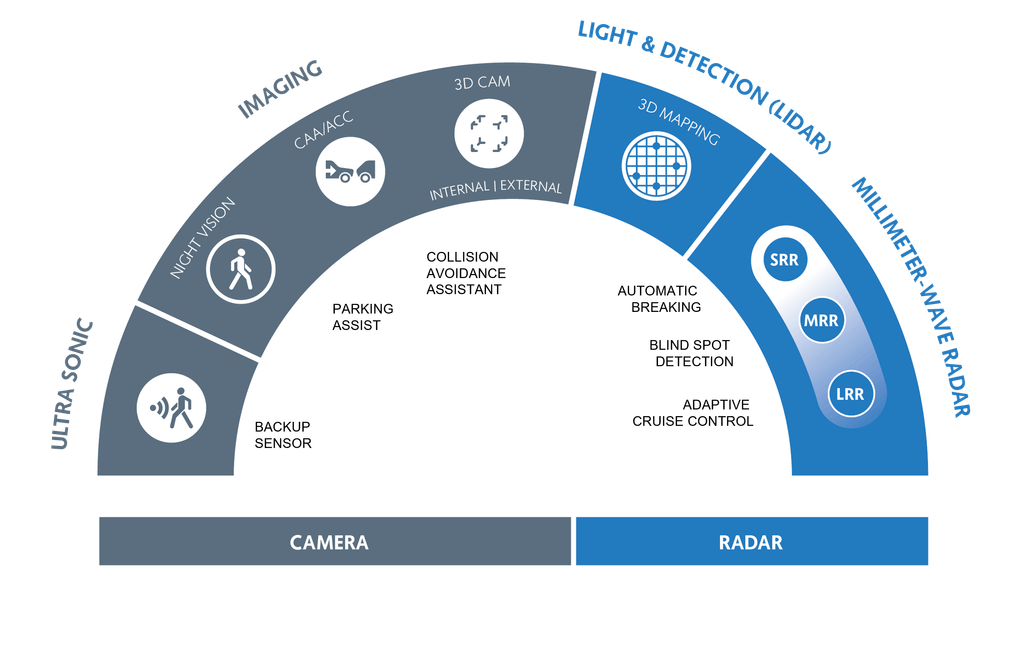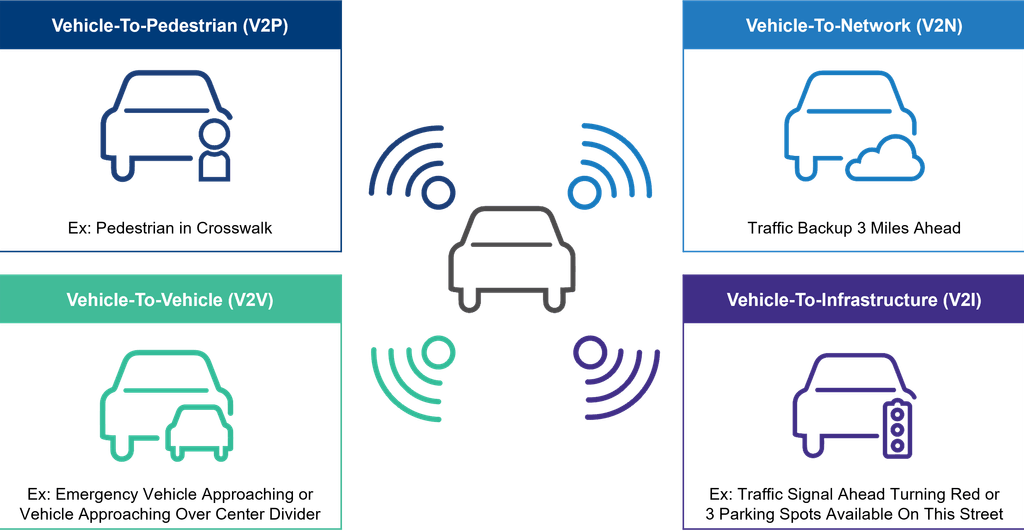We explore potentially life-saving advanced driver assistance system technology.
Key Points
- As investors, we believe that we can contribute to solving driver-error incidents by investing in technology that increases driver attentiveness and awareness, potentially reducing accidents and fatalities.
- While we still believe autonomous driving is in our future, it is likely to be further away than we expect owing to significant challenges.
- In our view, the growth of individual advanced driver assistance systems (ADASs) will also contribute to the bottom-up solutions that pave the way for autonomous vehicles.
Motor-vehicle accidents in the US have markedly increased over the last several years with an estimated 20,175 people dying in crashes in the first half of 2022 alone.[1] US Transportation Secretary Pete Buttigieg responded that “these deaths are preventable, not inevitable, and we should act accordingly.”[2]
Fully autonomous vehicles (AVs) could offer a solution to this sobering statistic, given their potential to reduce traffic accidents and save lives. However, AVs still have significant challenges to overcome and an unknown runway until adoption. In the meantime, there is a segment of the automobile industry that is already increasing vehicle safety. Specifically, companies are developing advanced driver assistance systems (ADASs) to reduce traffic accidents that occur from driver error. We believe that, as investors, we can contribute to solving driver-error incidents by investing in technology that increases driver attentiveness and awareness, potentially reducing accidents and fatalities.
Life-Saving Technology
The National Highway Traffic Safety Administration (NHTSA) is dedicated to keeping people safe on US roadways. Working with car manufacturers, the agency develops recommendations and guidelines for safety measures. In 2022, the NHTSA proposed to add four ADAS technologies in addition to those it already recommends. “These new technologies would include blind spot detection, blind spot intervention, lane-keeping assistance, and pedestrian automatic emergency braking.”[3]
Introducing advanced ADASs to new vehicles should incrementally improve driver safety, and in our view will form the building blocks needed to eventually move to fully autonomous vehicles.
ADASs: From Passive to Active Technology
ADAS technologies are designed to increase the safety of a vehicle by improving the driver’s ability to react to hazards on the road. Examples incorporated into today’s vehicles include adaptive cruise control, anti-lock brakes, collision warning, lane departure warning, traffic signal recognition and traction control.
Current ADASs are mostly passive, providing warnings and alerts to the driver. These technologies are moving toward more active systems that supersede driver decisions and autonomously take control of the vehicle, such as automatic braking systems. More advanced ADAS technology includes management functions, such as steering and propulsion without the need for hands-on control from the driver under certain conditions. In our view, this is where the greatest opportunities lie for technological advancement. Additionally, we view the main long-term goal as safety for not only the driver and passengers, but for everyone surrounding the vehicle, including pedestrians, cyclists and other motorists.
ADAS Systems Continue to Evolve

Original equipment manufacturers (OEMs) have sought to build their own ADASs and incorporate them in autonomous technology; however, some have made a strategic shift away from developing their own AV technology. Recently, a large American automobile company discontinued its investment in autonomous research to concentrate on further developing ADASs, reasoning that commercialization of autonomous vehicles is further away than originally projected and that it would be able to purchase AV technology developed by third parties. In our view, this is the crux of the investment opportunity as more players compete to develop active ADASs and integrate them into autonomous technology. The expected proliferation of such companies will also allow for more specialty to solve complex problems.
While current ADASs are making vehicles safer today, we believe that they could comprise the subsystems of tomorrow, making autonomous driving a reality. We are excited to invest in this progression and believe these technologies will make roads safer for all while striving for autonomy.
Roadblocks to Full Autonomy
In our view, once ADASs transition from passive to active, there are likely to be several barriers to fully autonomous vehicles – technical, regulatory, financial and cybersecurity.
For autonomous driving to exist, there need to be clear communication standards. A protocol must be established for communication, essentially enabling all vehicles to speak the same language. The below chart illustrates the various forms of vehicle communication.
Vehicle-to-Everything (V2X) Enables Vehicle Communication
“Vehicle-to-vehicle (V2V) communication’s ability to wirelessly exchange information about the speed and position of surrounding vehicles shows great promise in helping to avoid crashes, ease traffic congestion, and improve the environment. But the greatest benefits can only be achieved when all vehicles can communicate with each other.”[4]
Another obstacle on the road to autonomy is regulation. Currently, autonomous driving is regulated on a state-by-state level. Since 2012, the federal government has produced guidance that authorizes state governments to create autonomous guidelines. Currently, over 40 states have enacted laws that allow testing of autonomous vehicles with certain guidelines. For example, in 2016, Massachusetts created an executive order that established an Autonomous Working Group, as well as an application process to allow the testing of autonomous-equipped vehicles on public roads. This application process requires documentation of prior testing experience, a safety assessment, training and operations protocols, and a first responder interaction plan.[5]
While state laws on autonomous driving vary, until the federal government produces sweeping legislation to regulate self-driving vehicles, the end goal of autonomy cannot be reached.
Another issue among regulatory concerns is liability – who is responsible for accidents? Within the early stages of autonomy, including ADASs, the driver is responsible for accidents and insurance. However, as the vehicle moves higher up the scale of autonomy, the vehicle manufacturer is likely to become responsible. Are these automakers prepared for this liability and its consequences?
Cybersecurity is a critical issue that companies are working to address in vehicle technologies. As technologies advance and vehicles are connected to the internet, this leaves vehicles more vulnerable to cyber intrusions.
Finally, perhaps the largest obstacle to autonomy is financial. While testing any new technology is expensive, investing to achieve the final 1% can be all-consuming. There can be many edge cases that arise when finalizing any technology. For example, if a pedestrian is waiting on the curb for a ride share, how will this be communicated to an autonomous vehicle? How will the vehicle determine that the pedestrian is waiting for a ride instead of attempting to cross the street?
After considering these roadblocks, we believe it is not surprising that fully autonomous vehicles are not as close to fruition as some believe.
Investment Opportunities
In the meantime, the industry developing ADAS technology is likely to expand in both breadth and depth. While full autonomous capabilities are a great end solution, we believe that there is as great a benefit to focusing on its potential component parts, namely individual ADAS technologies.
ADASs need to be considered a ‘sum of the parts’ that aggregate to unified systems, but not necessarily full autonomy. Think of it as a synchronized active safety-management platform. Currently, ADAS subsystems typically work independently; for example, adaptive cruise control may leverage no input or data from what blind-spot detection is sensing.
The next move in ADASs will be a more holistic approach within the vehicle, by which all sensors within the vehicle are part of a central connected system, taking actions based on the amalgamation of sensor data, making smarter and more reliable decisions.
Long-Term View
While we still believe autonomous driving is in our future, it is likely to be further away than we expect owing to significant challenges. Furthermore, OEMs have found that in-house efforts to build ADASs and incorporate them into fully autonomous vehicles is inefficient. In the meantime, there is rapid growth of independent companies focused on ADAS technologies, particularly the transition from passive to active technologies that can provide additional safety measures to vehicles, preventing accidents and decreasing the motor vehicle fatality rate. In our view, the growth of individual ADASs will also contribute to the bottom-up solutions that pave the way for autonomous vehicles. Once these are achieved, we believe active ADASs, leading up to autonomous vehicles, will help make our roads safer and ultimately save lives.
[1] Source: https://www.nhtsa.gov/press-releases/early-estimates-traffic-fatalities-first-half-2022
[2] Source: https://www.nhtsa.gov/press-releases/early-estimates-traffic-fatalities-first-half-2022
[3] Source: https://www.nhtsa.gov/press-releases/early-estimates-traffic-fatalities-first-half-2022
[4] Source: https://www.nhtsa.gov/technology-innovation/vehicle-vehicle-communication
[5] Source: https://www.mass.gov/guides/testing-automated-driving-systems-in-massachusetts
PAST PERFORMANCE IS NOT NECESSARILY INDICATIVE OF FUTURE RESULTS. Any reference to a specific security, country or sector should not be construed as a recommendation to buy or sell this security, country or sector. Please note that strategy holdings and positioning are subject to change without notice. For additional Important Information, click on the link below.
Important information
For Institutional Clients Only. Issued by Newton Investment Management North America LLC ("NIMNA" or the "Firm"). NIMNA is a registered investment adviser with the US Securities and Exchange Commission ("SEC") and subsidiary of The Bank of New York Mellon Corporation ("BNY Mellon"). The Firm was established in 2021, comprised of equity and multi-asset teams from an affiliate, Mellon Investments Corporation. The Firm is part of the group of affiliated companies that individually or collectively provide investment advisory services under the brand "Newton" or "Newton Investment Management". Newton currently includes NIMNA and Newton Investment Management Ltd ("NIM") and Newton Investment Management Japan Limited ("NIMJ").
Material in this publication is for general information only. The opinions expressed in this document are those of Newton and should not be construed as investment advice or recommendations for any purchase or sale of any specific security or commodity. Certain information contained herein is based on outside sources believed to be reliable, but its accuracy is not guaranteed.
Statements are current as of the date of the material only. Any forward-looking statements speak only as of the date they are made, and are subject to numerous assumptions, risks, and uncertainties, which change over time. Actual results could differ materially from those anticipated in forward-looking statements. No investment strategy or risk management technique can guarantee returns or eliminate risk in any market environment and past performance is no indication of future performance.
Information about the indices shown here is provided to allow for comparison of the performance of the strategy to that of certain well-known and widely recognized indices. There is no representation that such index is an appropriate benchmark for such comparison.
This material (or any portion thereof) may not be copied or distributed without Newton’s prior written approval.








